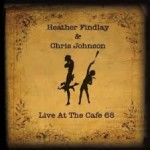Heather Findlay made début as a solo artist with a full band with a couple of festival appearances back in August. After an acoustic support slot for Touchstone in October, she came to Fibbers in her home town of York as the second date of her much-anticipated first tour as a headline act.
The venue was packed. Her former band Mostly Autumn were playing their annual home town showcase at The Grand Opera House the following night, which encouraged many fans to make a weekend of it and take in both shows. And it was nice to see her former Mostly Autumn band-mates Bryan Josh, Olivia Sparnenn, Anne-Marie Helder and Angela Gordon in the audience.
Support came from Shadow of the Sun, the new project featuring Dylan Thompson, formerly of The Reasoning, on lead guitar. They played a tight high-energy hard rock set which showed a lot of promise for the future. I’m sure we’ll be hearing a lot more of these guys in the coming months.
The atmosphere was electric with anticipation by the time Heather and her band hit the stage and launched into the title track of “The Phoenix Suite”. This was Heather in full-on rock mode. The full band shows delivered a very different experience to the acoustic sets with Chris Johnson supporting Touchstone, even though a lot of songs were common to both.
Over the course of the next hour and a half, the lengthy and varied set proved Heather still has all that magic from her time in Mostly Autumn. She’s assembled a very talented band. Alongside multi-instrumentalist Chris Johnson, Dave Kilminster’s guitar playing is a great example of restrained virtuosity, acting as a foil for Heather’s lead vocal without overplaying, and Steve Vantsis and Alex Cromarty make for a powerful rhythm section. The end result felt far more like a band than a solo artist backed by anonymous session musicians. Having the best sound mix I’d heard at any gig at Fibbers since refurbishment didn’t hurt either.
On the songs from The Phoenix Suite the band kept close to the original arrangements, although all the songs benefited greatly from a thicker guitar sound, with “Seven” particularly memorable. The only significant change was Dave Kilminster’s playing the sort of melodic and expressive solo on “Mona Lisa” that I’d loved to have heard on the original record.
The rest of the set consisted of Heather’s older songs, many of them radically reworked. Rather than play all of the obvious standards like “Evergreen”, they took us on a tour of less well-known highlights from her songbook, drawing heavily from Mostly Autumn’s “Heart Full of Sky” and “Glass Shadows”, including many songs seldom, or in some cases never before played live.
Without the walls of keys, there was a lot more space in the arrangements, with Dave Kilminster’s guitar taking flute and clarinet lines in songs like “Caught in a Fold” and “Blue Light”. An acoustic interlude with upright bass, mandolin and ukelele(!) featured a surprisingly funky take on Odin Dragonfly’s “This Game” and a great version of Mostly Autumn’s “Unoriginal Sin”. In contrast, Odin Dragonfly’s “Magpie” turned into a full-on rock number complete with a shredding solo at the end.
The encores began just Heather accompanied by Chris on piano, with a medley of “Broken”, a few bars of “Carpe Diem” leading into “Bitterness Burnt” and a deeply moving “Paper Angels”, which saw the band return for the closing section. They left us with what had become one of Heather’s signature songs, a mesmerising “Shrinking Violet”.
Playing a full-length headline set with only a five song EP’s worth of new material was always going to be a bit of a risk, but the completely fresh takes on the older songs made for a great gig. Significantly, they played a set made up largely from Mostly Autumn songs without sounding much like Mostly Autumn at all. It’s a show unlikely to be repeated once Heather has written and recorded more new songs, so catch it while you can at the last two dates on the tour, at The Borderline on the 26th, and The Robin in Bilston the following night.










 “Live at the Café 68″ is York singer-songwriter Heather Findlay’s second release since leaving as lead singer of Mostly Autumn in 2010. Recorded before an intimate audience of just thirty people, it’s a stripped-down acoustic album featuring fellow singer-songwriter Chris Johnson on guitar and vocals.
“Live at the Café 68″ is York singer-songwriter Heather Findlay’s second release since leaving as lead singer of Mostly Autumn in 2010. Recorded before an intimate audience of just thirty people, it’s a stripped-down acoustic album featuring fellow singer-songwriter Chris Johnson on guitar and vocals.